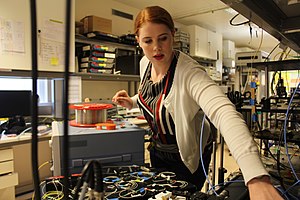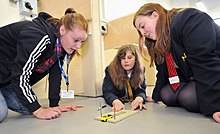Women in engineering
Prior to the creation of the term "engineer" in the 14th century, women had contributed to the technological advancement of societies around the globe.
Ada Lovelace was privately schooled in mathematics before beginning her collaboration with Charles Babbage on his analytical engine that would earn her the designation of the "first computer programmer."
In the early years of the 20th century, greater numbers of women began to be admitted to engineering programs, but they were generally looked upon as anomalies by the men in their departments.
[2] Prior to the 19th century, it was very rare for women to earn bachelor's degree in any field because they did not have the opportunity to enroll in universities due to gender disparities.
[2]In the United States, the entry into World War II created a serious shortage of engineering talent, as men were drafted into the armed forces.
[4] Women's roles in the workforce, specifically in engineering fields, changed greatly during the Post–World War II period.
[5] Women also played a crucial role in programming the ENIAC from its construction during the World War II period through the next several decades.
Originally recruited by the Army in 1943, female ENIAC programmers made considerable advancements in programming techniques, such as the invention of breakpoints, now a standard debugging tool.
[9] At a young age, girls typically do not express the same level of interest in engineering as boys, possibly due in part to gender stereotypes.
[11] Women who persist are able to overcome these difficulties, enabling them to find fulfilling and rewarding experiences in the engineering profession.
[16][17] A study by the Harvard Business Review discussed the reasons why the rate of women in the engineering field is still low.
The study discovered that rates of female students in engineering programs are continuous because of the collaboration aspects in the field.
Research shows that these rates are difficult to increase since women are judged as less competent than men to perform supposedly “masculine jobs”.
[19] Another possible reason for lower female participation in engineering fields is the prevalence of values associated with the male gender role in workplace culture.
Other typically masculine traits, such as workplace sexual harassment and creating a hostile work environment also certainly contribute to this atmosphere of domineering attitudes towards women.
[23] Over the past several decades, women's representation in the workforce in STEM fields, specifically engineering, has slowly improved.
Their strategies include increasing women's exposure to STEM courses during high school, planting the idea of a positive outlook on female participation from the engineering culture, and producing a more female-friendly environment inside and outside the classroom.
[24] In 2014, there were 7.9% female freshmen among all first-year students planning to study in STEM (science, technology, engineering, and mathematics) related majors.
[39] The number of women enrolled in undergraduate, graduate, and doctoral engineering programs tends to vary by province, with the proportion in Newfoundland and Labrador, Prince Edward Island, and Alberta.
[41] CCWE+20 identified a goal of increasing women's interest in engineering by 2.6% by 2016 to a total of 25% through more incentives such as through collaboration and special projects.
[41] The workshop identifies early education as one of the main barriers in addition to other factors, such as: "the popular culture of their generation, the guidance they receive on course selection in high school and the extent to which their parents, teachers, and counsellors recognize engineering as an appropriate and legitimate career choice for women.
The industry average salary is £48,000[44] The 2016 Hollywood film Hidden Figures follows three African American women engineers' work at NASA in 1960.
In 2019, Mary Robinette Kowal published SF novel The Calculating Stars, which also tells the story of women engineers working in NASA around the same period.



